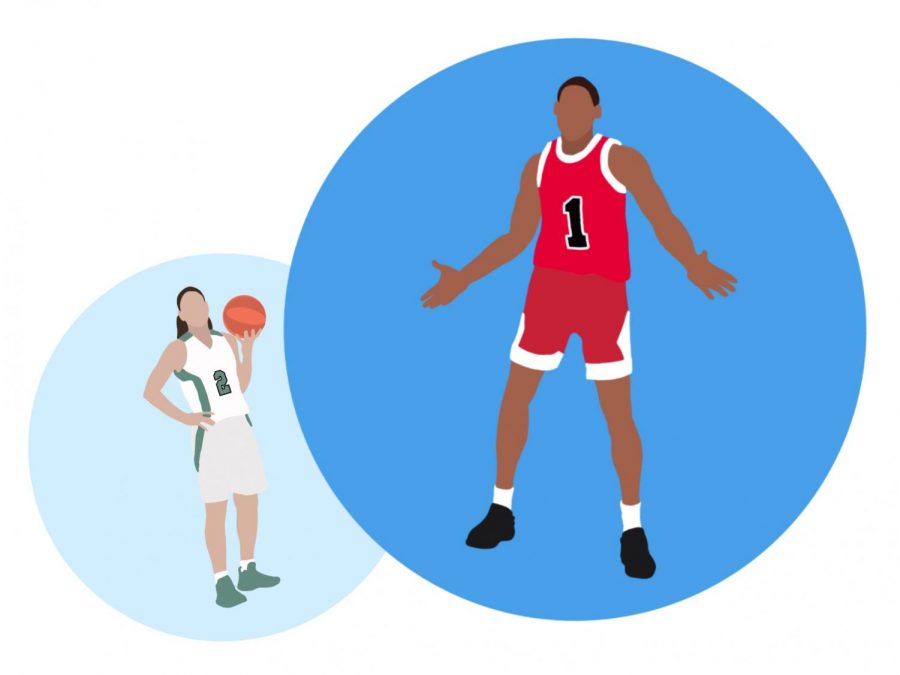Whose Bubble Is Bigger?
NCAA inequality comes to light during March Madness
After a year-long hiatus, the biggest tournament in the NCAA is back. Teams have put in countless hours to see time on a court. They have given themselves the opportunity to potentially hoist the most prized trophy in all of college basketball. Of course, this year, it is important to note that the same opportunity is provided to men and women. Although, that does not necessarily mean they are provided the same means to attain it.
The men’s tournament is taking place in a bubble in Indianapolis where the teams spend 24 hours of their day in a huge convention center. Within the convention center, there are practice courts, team rooms where teams can watch film, movies, bond, study and enjoy free time. But where they lift has become a huge source of contention in less than a week.
The women’s tournament, taking place in San Antonio, looks significantly different from the men’s tournament. While the general premise should be the same, the reality looks significantly different. On March 19, the first alarm of inequality sounded. The comparison between the men’s and women’s weight rooms were released to the public by athletes. The men’s weight room was enough to make any regular gym goer envious. With at least 15 racks, beautifully stacked weights and a dumbbell section longer than the men of the tournament are tall, the men of the tournament were understandably awed. For a few teams, the weight room for the tournament rivaled their school’s. Alternatively, the women were provided with a dumbbell rack. To add insult to injury, the highest weight of the dumbbells provided were thirty pounds.
The worst part of the story, however, was that the weight room was not the only thing with severe imbalances. Quickly, comparisons of the food were leaked along with comparisons of the gift packages players received. While the men received, large, catered buffet meals, the women were given single serving meals with unidentifiable meat. While the men were given huge gift packages with a blanket, flag, plenty of toiletries and various other tournament specific merch, the women’s package was comparatively miniscule. Given a small towel, socks, a drawstring bag and a fraction of the toiletries men’s teams were provided, the women felt snubbed when it was made apparent that the men’s packages were larger. As if it had not been obvious enough, perhaps the biggest insult came through the puzzles that were given to every player. To the women—a 150 piece puzzle promoting the tournament. To the men—a 300 piece. If the entire situation were to be summed up, this comparison arguably speaks the loudest.
Within the last year, social media has taken up a prominent role keeping people connected. It allows for the closest connection that can be provided during a worldwide pandemic. The players utilized it to their advantage. Sharing photos with one another and then eventually the public, the pictures provided the fuel for a fury of female athletes. Administrators, coaches, players and families took to the internet to voice their opinions and their disgust with the NCAA. The general sentiment: How can an organization that claims to champion female athletes put them in such an obviously undervalued position?
In addition to the athletes themselves, professional athletes, professional coaches and previous NCAA coaches, strength trainers (men and women alike), NCAA administrator, and athletes in the men’s tournament have all added their voices to the problems surrounding the inequality. Joined together, the outcry caused immediate action from the NCAA. Within 24 hours, the women’s weight room had improved considerably. For starters, there was one. Now the women have racks, dumbbells past thirty pounds and a designated area for strength training. Exponential improvements from the first situation.
While the NCAA has released various statements regarding the slip up, many feel the statements do not reflect the reality of the situation. A valid question posed by many was why the NCAA felt so comfortable with such an objectively awful situation. Was it that they simply thought no one would notice? Is it that they assumed it would not be a big deal? Are they being honest saying they did not have the space to provide such resources?
The whole situation has left a black smudge on the NCAA’s efforts claiming them as an equal showroom for athletes. In 2021, such blatant inequality feels reminiscent of the pre-Title IX days. Albeit, there are positives that have resulted. For one, it signaled to female athletes that their voices can cause immediate change. Two, it serves as a reminder that there is always work to be done. If the one organization that has all the incentive to equally provide for its female and male athletes cannot do so without referees, it is important to make sure people are holding one another accountable. Finally, it has created a big conversation. What started as pictures and videos on social media has built into ammunition to change conversations. One example is the push to designate the men’s tournament as men’s and the women’s tournament as women’s. The calling comes from the idea that the women’s tournament has always been designated as such and the men’s tournament has become assumed as the default.
March Madness has gotten its name for the chaos that ensues. Usually, that chaos comes from upsets and Cinderella stories. In a year dominated by social change and advocacy, it makes disappointing sense that it would apply here as well. This year, the men’s tournament has drawn considerable attention for the upsets and overthrows but the women’s tournament holds plenty of madness in its own right. Ultimately, this situation has started the conversation for other means of improvement throughout the NCAA. This year’s madness will certainly be historic. The women of the tournament will continue to push for historic wins and historic change.
Your donation will support the student journalists of Saint Louis University.





